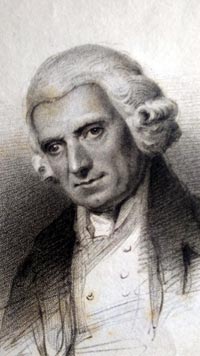THEY LIVED IN LEEDS
William Hey FRS (1736-1819)
‘The Father of Leeds Surgery’
 In 1809 the body of the Leeds ‘witch’ Mary Bateman, hanged at York for murder, was brought to Leeds Infirmary for public dissection by the eminent surgeon William Hey. As each part of the body was dissected he presented an anatomical lecture, twelve in all. He attracted a ‘very numerous and respectable’ paying audience, though women were admitted only for his lecture on the eye. All the profits went to the Infirmary which he had been instrumental in founding and had helped to develop into a top provincial hospital. He had given popular anatomical demonstrations before, both in Leeds and to fellow-surgeons in London. Now in his seventies he was Leeds’ foremost surgeon, with formidable experience and knowledge, author of a major work on surgery, and one of the most influential men in Leeds civic and cultural life. All this in the face of disability and misfortune.
In 1809 the body of the Leeds ‘witch’ Mary Bateman, hanged at York for murder, was brought to Leeds Infirmary for public dissection by the eminent surgeon William Hey. As each part of the body was dissected he presented an anatomical lecture, twelve in all. He attracted a ‘very numerous and respectable’ paying audience, though women were admitted only for his lecture on the eye. All the profits went to the Infirmary which he had been instrumental in founding and had helped to develop into a top provincial hospital. He had given popular anatomical demonstrations before, both in Leeds and to fellow-surgeons in London. Now in his seventies he was Leeds’ foremost surgeon, with formidable experience and knowledge, author of a major work on surgery, and one of the most influential men in Leeds civic and cultural life. All this in the face of disability and misfortune.
He was born in 1736 in Pudsey, his father a respected merchant and his mother the daughter of a Leeds surgeon – medicine in his blood. His childhood was marred by accidents: at three he was burnt when his nightdress caught fire, and a year later his penknife slipped cutting a piece of string and blinded him in one eye. Undeterred, he prospered at school, loved learning, science and music (played the flute), and at fourteen was apprenticed to an apothecary/surgeon in Leeds to learn the skills of the trade. At 21 he left for London to further his studies with the leading surgeons of the time, spending long hours in lectures, wards, and hospital dissecting rooms, mastering anatomy.
Back in Leeds in 1759 he set up as an apothecary/surgeon, but patients were slow coming: there was no hospital for major operations and his ardent Methodism may have deterred some. But he built up a reputation working as surgeon at the workhouse, and in 1767 led the campaign to establish the Leeds General Infirmary for the sick and poor. He was appointed surgeon – ‘we cannot do without him’ it was said – and soon chief surgeon. He was to work there 45 years. In addition he attracted a range of private patients, some high status, including his friend William Wilberforce whose anti-slavery principles he shared. He practised as a general surgeon but also obstetrician – a ‘man-midwife’. His detailed case notes survive, revealing his humane approach to his patients, rich or poor, his thoughtful observations on treatment, his successes and failures.
In 1761 he married Alice Banks ‘an agreeable young lady with a handsome fortune’ – but this fortunate marriage was overshadowed. Of their fourteen children four died in infancy and five were later to die in their twenties, a cruel loss. His fervent religious faith helped to sustain him. Then an accident damaged his knee and made walking difficult, followed later by a fall from his horse which crippled him completely. Yet he continued to work, even expanded his practice, using a crutch to move around and a carriage to reach his distant patients.
Deeply interested in science, philosophy, morality and religion, he had a circle of like-minded friends, among them the scientist and philosopher Joseph Priestley, who in 1775 proposed Hey for the prestigious Fellowship of the Royal Society: a feather in his cap, enhancing his reputation. With Priestley he was a founder member of the elite Leeds Library, and in 1783 formed the Leeds Philosophical and Literary Society. It was short-lived but was revived in 1819 with his personal backing – and still flourishes today, 200 years on.
Meanwhile he played an increasingly prominent role in civic life, first as Alderman then twice as Mayor , though his strong religious views on the evils of drink and the keeping of the Sabbath made him deeply unpopular with the Leeds crowds. In his first term as Mayor in 1787 his effigy was burnt, his carriage attacked by a mob and the horses stabbed, terrifying his wife. But he had an assured social position now and was prospering – look at the splendid new house he had built in 1794 in Albion Place, set then in two acres of gardens (blue plaque).
He published ‘Observations on the Blood’ in 1779, and in 1803 his major work ‘Practical Observations in Surgery’, describing in detail, with illustrations, his various cases and operations and the instruments he used. His work represented an important step forward towards a more scientific approach to surgery and his name still survives in some surgical terms today. Two of his sons were to follow in his footsteps.
‘
He was 83 when he died in 1819, after 60 years of practice. There was a rush to celebrate the long life of this remarkable man who, sustained by religious faith and strong principles, had overcome injury and adversity to become one of Leeds’ most eminent men.
Eveleigh Bradford
October 2018